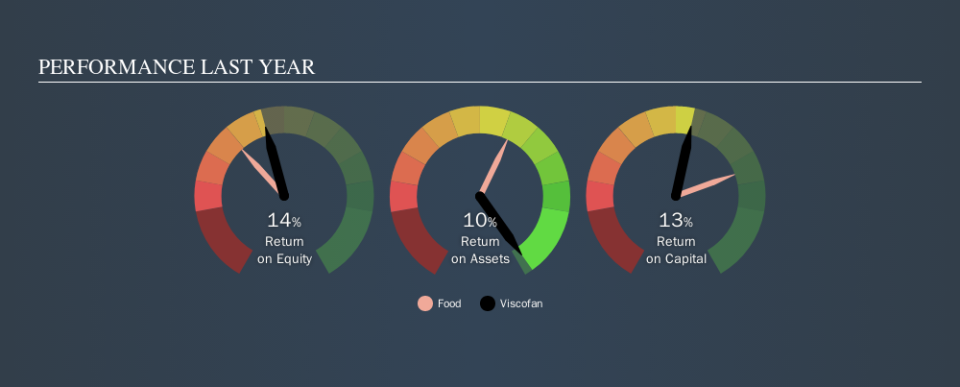Viscofan, S.A. (BME:VIS) Earns Among The Best Returns In Its Industry

Today we'll look at Viscofan, S.A. (BME:VIS) and reflect on its potential as an investment. Specifically, we'll consider its Return On Capital Employed (ROCE), since that will give us an insight into how efficiently the business can generate profits from the capital it requires.
First, we'll go over how we calculate ROCE. Next, we'll compare it to others in its industry. Last but not least, we'll look at what impact its current liabilities have on its ROCE.
Understanding Return On Capital Employed (ROCE)
ROCE measures the amount of pre-tax profits a company can generate from the capital employed in its business. All else being equal, a better business will have a higher ROCE. Overall, it is a valuable metric that has its flaws. Renowned investment researcher Michael Mauboussin has suggested that a high ROCE can indicate that 'one dollar invested in the company generates value of more than one dollar'.
How Do You Calculate Return On Capital Employed?
The formula for calculating the return on capital employed is:
Return on Capital Employed = Earnings Before Interest and Tax (EBIT) ÷ (Total Assets - Current Liabilities)
Or for Viscofan:
0.13 = €121m ÷ (€1.1b - €180m) (Based on the trailing twelve months to June 2019.)
So, Viscofan has an ROCE of 13%.
See our latest analysis for Viscofan
Does Viscofan Have A Good ROCE?
When making comparisons between similar businesses, investors may find ROCE useful. In our analysis, Viscofan's ROCE is meaningfully higher than the 9.1% average in the Food industry. We would consider this a positive, as it suggests it is using capital more effectively than other similar companies. Independently of how Viscofan compares to its industry, its ROCE in absolute terms appears decent, and the company may be worthy of closer investigation.
We can see that, Viscofan currently has an ROCE of 13%, less than the 20% it reported 3 years ago. This makes us wonder if the business is facing new challenges. You can click on the image below to see (in greater detail) how Viscofan's past growth compares to other companies.
Remember that this metric is backwards looking - it shows what has happened in the past, and does not accurately predict the future. ROCE can be misleading for companies in cyclical industries, with returns looking impressive during the boom times, but very weak during the busts. ROCE is only a point-in-time measure. Future performance is what matters, and you can see analyst predictions in our free report on analyst forecasts for the company.
How Viscofan's Current Liabilities Impact Its ROCE
Short term (or current) liabilities, are things like supplier invoices, overdrafts, or tax bills that need to be paid within 12 months. Due to the way ROCE is calculated, a high level of current liabilities makes a company look as though it has less capital employed, and thus can (sometimes unfairly) boost the ROCE. To counteract this, we check if a company has high current liabilities, relative to its total assets.
Viscofan has total assets of €1.1b and current liabilities of €180m. As a result, its current liabilities are equal to approximately 17% of its total assets. Current liabilities are minimal, limiting the impact on ROCE.
The Bottom Line On Viscofan's ROCE
This is good to see, and with a sound ROCE, Viscofan could be worth a closer look. Viscofan shapes up well under this analysis, but it is far from the only business delivering excellent numbers . You might also want to check this free collection of companies delivering excellent earnings growth.
Viscofan is not the only stock insiders are buying. So take a peek at this free list of growing companies with insider buying.
We aim to bring you long-term focused research analysis driven by fundamental data. Note that our analysis may not factor in the latest price-sensitive company announcements or qualitative material.
If you spot an error that warrants correction, please contact the editor at editorial-team@simplywallst.com. This article by Simply Wall St is general in nature. It does not constitute a recommendation to buy or sell any stock, and does not take account of your objectives, or your financial situation. Simply Wall St has no position in the stocks mentioned. Thank you for reading.


